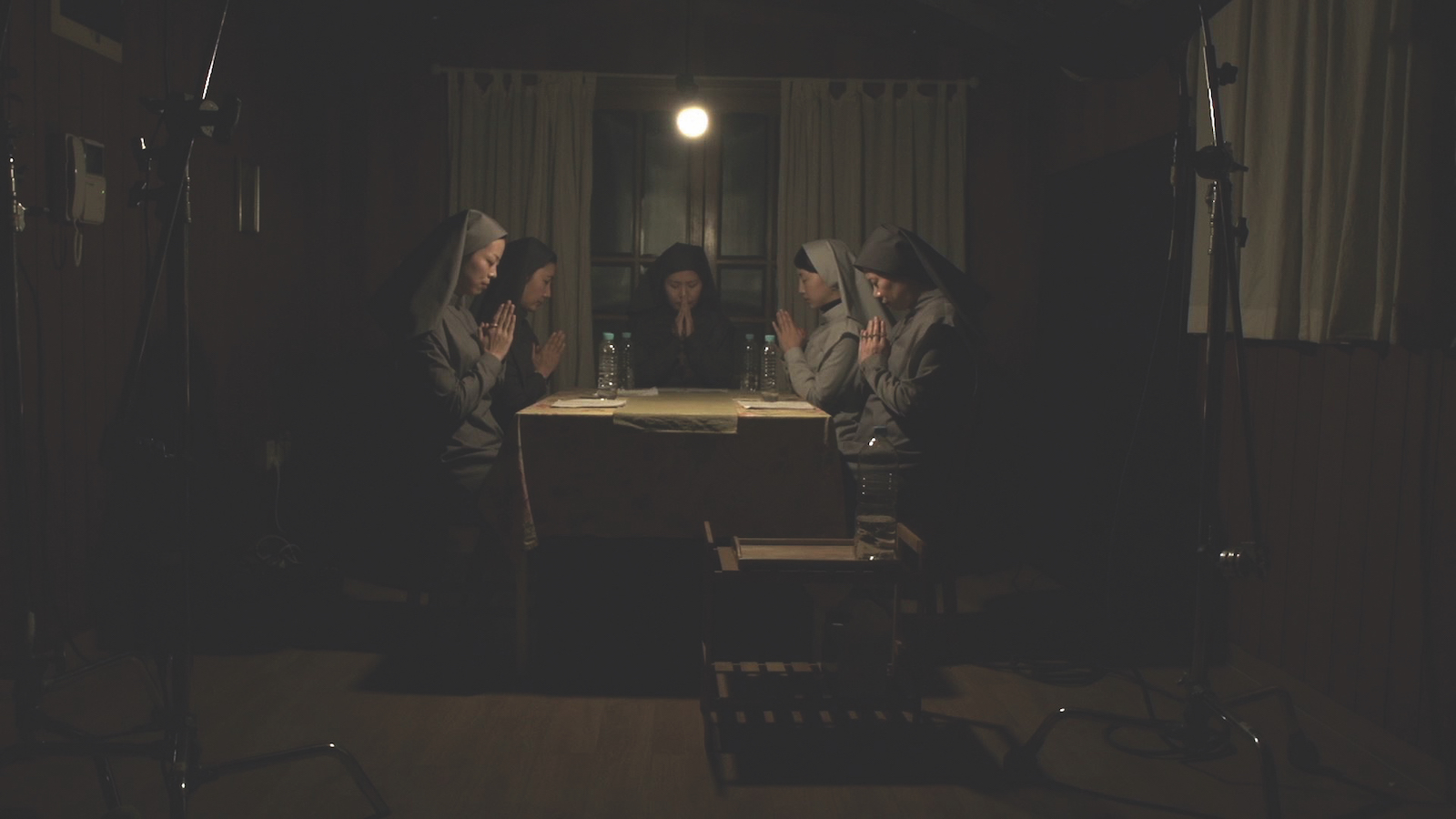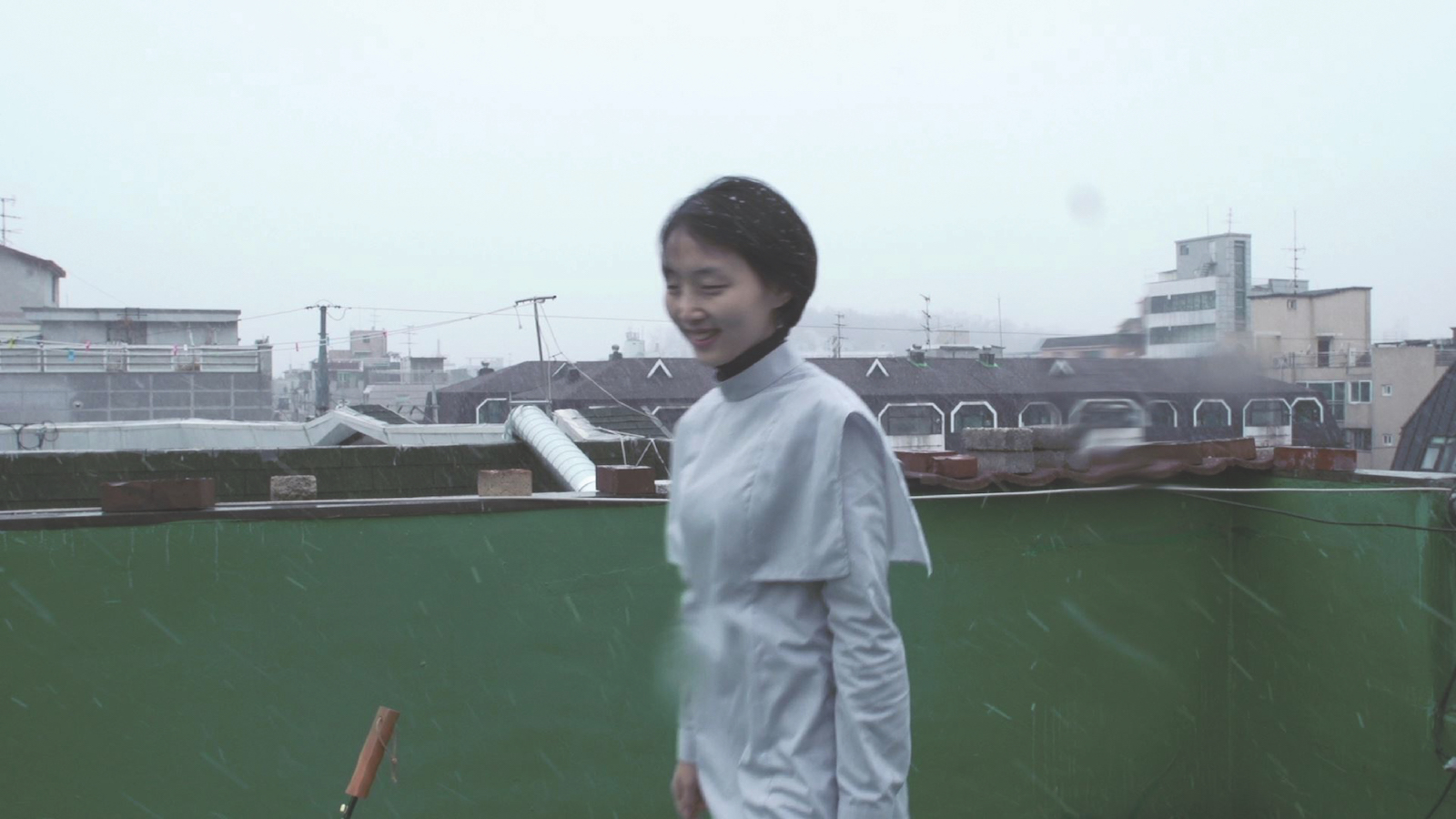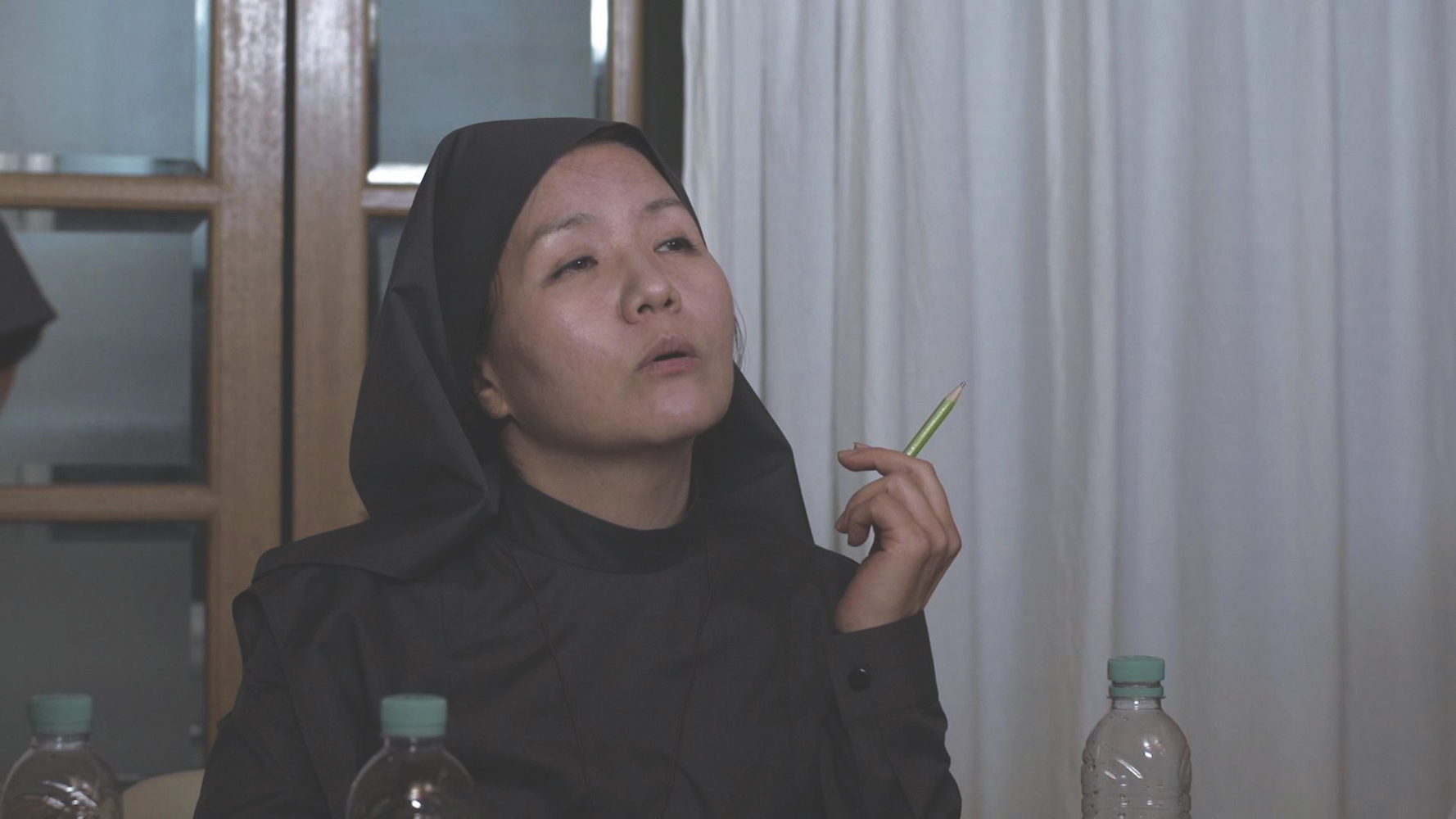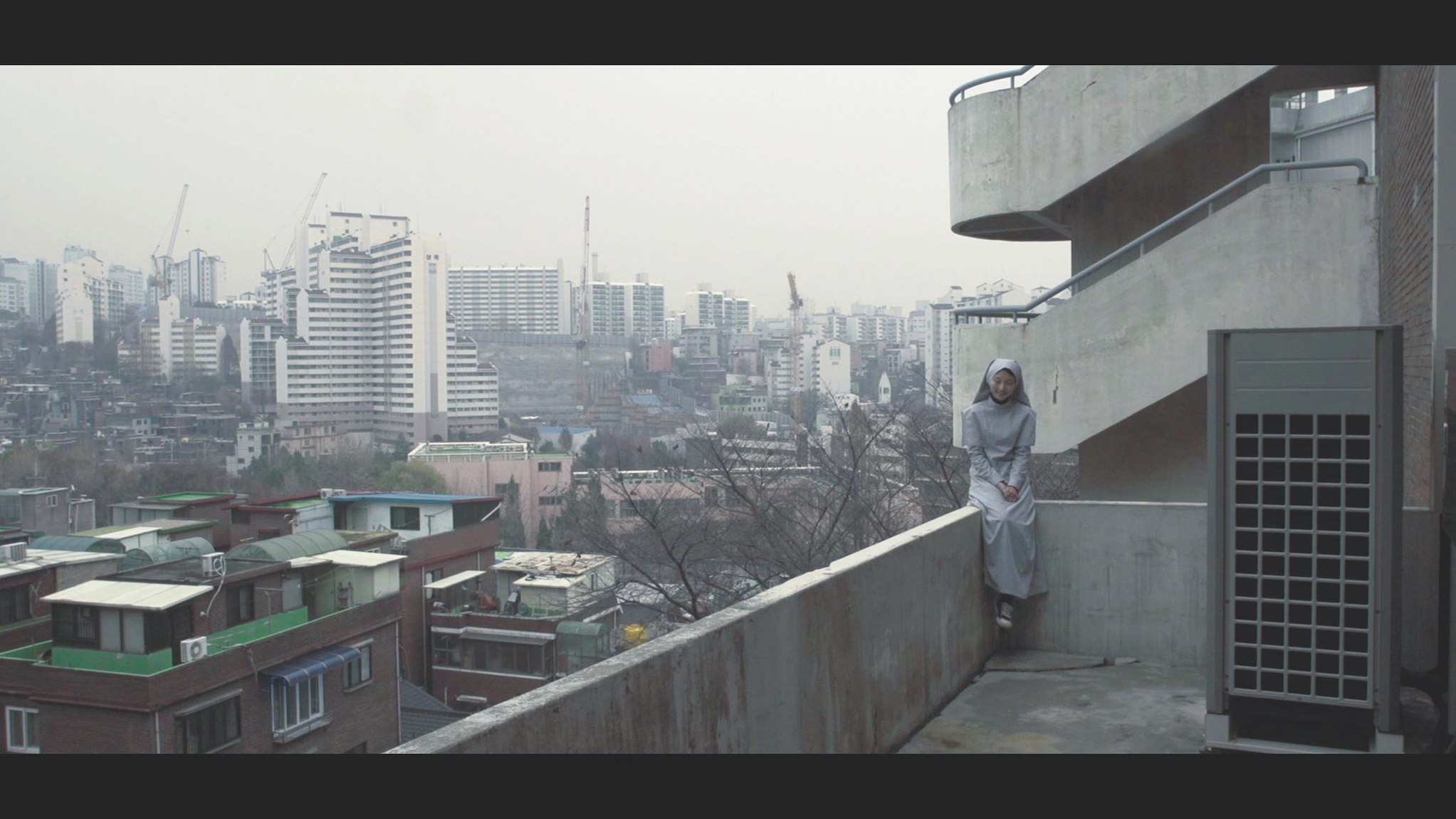Inbetween Stage
- Video
Youja Kim- leodipri@gmail.com




[IDENTITY may be a -, a personality, a job, a -, or a style of handwriting.]
When I just saw a catholic nun in the bus, it was an afternoon, I suddenly wondered if the nuns would also wear a bra, and how long would they carry it for a day. It might be a trivial question which belongs to my personal standpoint. I worked over this question and tried to penetrate deep into it seeking for its hidden side. Why I asked it?
Korean nuns* may be symbolized by their dark achromatic habit and hood. Their feminity seems to be veiled. The question situate over a stranger's eyes looking this characteristic appearance. Actually nuns live a particular life just like their habit which identify them from 'not-nuns'. They manage a living community where they give up their private properties and rather manage joint property, and pledge their life under the vow for God. What kind of association and importance would exist between their lifestyle and their feminity?
shows the instant of nuns, actors, woman, or Men coming and going between several identities in the set of a changeroom: a fantasied space. There are 3 layers of construction for this story. In the very inner part resides the story of a community of 5 nuns, outside of it the story of actors playing the 5 nuns, finally at the very edge of these, story of each of very individual. The changeroom transfigures depending on how we interpret the character. Along my work, I wanted to figure out the spot where, how and why a person's identity forms.
The research for the life of nuns is at once a way for knowing nuns as a stranger, and also a way for knowing the world full of being strangers without me(and sometimes I'm strange to me too).
*At the 2nd Vatican Council held in the late 20th century, new interpretations were made over catholic church's system, dogmas, rituals etc, and a sensation of reform was created. Catholic Church embraces several changes, including nuns' habit. Since then in Europe, America etc, nuns put on plain clothes whereas asian countires seldom relinquish the tradition of uniform(In South Korea, convents wearing habit and hood are majority. Even where convents abroad that don't put habit, when it comes to Korea the rule change). </div>
When I just saw a catholic nun in the bus, it was an afternoon, I suddenly wondered if the nuns would also wear a bra, and how long would they carry it for a day. It might be a trivial question which belongs to my personal standpoint. I worked over this question and tried to penetrate deep into it seeking for its hidden side. Why I asked it?
Korean nuns* may be symbolized by their dark achromatic habit and hood. Their feminity seems to be veiled. The question situate over a stranger's eyes looking this characteristic appearance. Actually nuns live a particular life just like their habit which identify them from 'not-nuns'. They manage a living community where they give up their private properties and rather manage joint property, and pledge their life under the vow for God. What kind of association and importance would exist between their lifestyle and their feminity?
The research for the life of nuns is at once a way for knowing nuns as a stranger, and also a way for knowing the world full of being strangers without me(and sometimes I'm strange to me too).
*At the 2nd Vatican Council held in the late 20th century, new interpretations were made over catholic church's system, dogmas, rituals etc, and a sensation of reform was created. Catholic Church embraces several changes, including nuns' habit. Since then in Europe, America etc, nuns put on plain clothes whereas asian countires seldom relinquish the tradition of uniform(In South Korea, convents wearing habit and hood are majority. Even where convents abroad that don't put habit, when it comes to Korea the rule change). </div>
[정체성은 어떤 -이거나 성격, 직업,-, 또는 글씨체이기도 하다.]
문득 떠올랐던 질문을 시작으로 삼은 작업. 버스를 올라타던 수녀를 보고 ""수녀들도 브래지어를 찰까, 그들은 하루 평균 몇 시간쯤 착용하나"" 궁금했다. 질문은 무척 개인적이고 사소하다. 이 작업은 내 질문 속을 스스로 파고들어가면서 사소한 질문의 이면을 찾아가는 과정이기도 했다.
어두운 무채색 천과 두건으로 상징되는 '한국의' 수녀들*은 그 자신의 여성적 정체성을 가리고 있다는 인상을 준다. 위의 질문은 이런 외양에 대한 나라는 외부인의 시선에서 비롯된다. 실제로 수녀들은 의복뿐 아니라 수녀가 아닌 우리와 다른 일상을 산다. 수녀들끼리 모여 사는 공동체(-작은 사회)를 형성하고, 개인의 재산은 많은 부분 반납, 공동 소유하며 그 안에서 종교적 교리와 소명에 걸맞게 살아간다. 이런 삶과 그 자신들의 여성성은 어떤 연관과 중요성을 가질까.
<중간적 단계의="" 탈의실="">은 탈의실이라는 상상의 공간을 거치는 수녀, 배우, 여자 그리고 더 야망있게는 인간존재가 여러 정체성을 오가는 순간을 시각적으로 포착한다. 영상은 크게 세 겹의 구조로 건축됐다. 가장 안 쪽에 어느 수녀 공동체 내 다섯 수녀들 이야기가 있고, 그 바깥에 그런 수녀를 연기하는 배우들의 이야기, 그리고 그에서 확장한 배우 개인의 이야기가 있다. 탈의실은 각 인물이 누구, 어떤 사람과 정체성으로 읽히느냐에 따라 다른 공간으로 변모한다. 한 사람의 정체성이 형성되는 순간들은 언제이고, 어떻게 왜 형성될까. 작업을 진행하며 궁극적으로 알아보고 싶었던 것이다.
방향성이 뚜렷한 삶을 사는 수녀들의 생활을 담아보고 싶었던 건 타자인 수녀들을 알아가는 것이기도 하지만, 나 이외 모두가 타자인 세계에 대한 한 가지 탐구이고 싶다.
*(각주)20세기 후반 열린 제 2차 바티칸 공의회에서는 교회가 이어온 제도들과 교리, 의식 등에 대해 새로이 해석하고 개혁의 반향을 불러일으켰다. 세계 각지의 카톨릭 교회가 변화를 맞고, 복식도 여러 변화들 중 하나였다. 유럽과 미국 등의 수녀들은 그 이후 사복을 입는 것이 자연스러우나, 아시아계 국가들은 일명 '제복'에 대한 포기가 덜하다고 한다(우리나라는 사복 수녀회보다 수녀복을 입는 수녀회가 훨씬 다수. 심지어 외국에서 사복 수녀회인 곳들도 한국에 오면 같은 수녀회임에도 수녀복을 입는 경우도 있다). </div>
문득 떠올랐던 질문을 시작으로 삼은 작업. 버스를 올라타던 수녀를 보고 ""수녀들도 브래지어를 찰까, 그들은 하루 평균 몇 시간쯤 착용하나"" 궁금했다. 질문은 무척 개인적이고 사소하다. 이 작업은 내 질문 속을 스스로 파고들어가면서 사소한 질문의 이면을 찾아가는 과정이기도 했다.
어두운 무채색 천과 두건으로 상징되는 '한국의' 수녀들*은 그 자신의 여성적 정체성을 가리고 있다는 인상을 준다. 위의 질문은 이런 외양에 대한 나라는 외부인의 시선에서 비롯된다. 실제로 수녀들은 의복뿐 아니라 수녀가 아닌 우리와 다른 일상을 산다. 수녀들끼리 모여 사는 공동체(-작은 사회)를 형성하고, 개인의 재산은 많은 부분 반납, 공동 소유하며 그 안에서 종교적 교리와 소명에 걸맞게 살아간다. 이런 삶과 그 자신들의 여성성은 어떤 연관과 중요성을 가질까.
<중간적 단계의="" 탈의실="">은 탈의실이라는 상상의 공간을 거치는 수녀, 배우, 여자 그리고 더 야망있게는 인간존재가 여러 정체성을 오가는 순간을 시각적으로 포착한다. 영상은 크게 세 겹의 구조로 건축됐다. 가장 안 쪽에 어느 수녀 공동체 내 다섯 수녀들 이야기가 있고, 그 바깥에 그런 수녀를 연기하는 배우들의 이야기, 그리고 그에서 확장한 배우 개인의 이야기가 있다. 탈의실은 각 인물이 누구, 어떤 사람과 정체성으로 읽히느냐에 따라 다른 공간으로 변모한다. 한 사람의 정체성이 형성되는 순간들은 언제이고, 어떻게 왜 형성될까. 작업을 진행하며 궁극적으로 알아보고 싶었던 것이다.
방향성이 뚜렷한 삶을 사는 수녀들의 생활을 담아보고 싶었던 건 타자인 수녀들을 알아가는 것이기도 하지만, 나 이외 모두가 타자인 세계에 대한 한 가지 탐구이고 싶다.
*(각주)20세기 후반 열린 제 2차 바티칸 공의회에서는 교회가 이어온 제도들과 교리, 의식 등에 대해 새로이 해석하고 개혁의 반향을 불러일으켰다. 세계 각지의 카톨릭 교회가 변화를 맞고, 복식도 여러 변화들 중 하나였다. 유럽과 미국 등의 수녀들은 그 이후 사복을 입는 것이 자연스러우나, 아시아계 국가들은 일명 '제복'에 대한 포기가 덜하다고 한다(우리나라는 사복 수녀회보다 수녀복을 입는 수녀회가 훨씬 다수. 심지어 외국에서 사복 수녀회인 곳들도 한국에 오면 같은 수녀회임에도 수녀복을 입는 경우도 있다). </div>
All rights reserved © 홍익대학교 디자인학부 시각디자인전공 졸업전시회 2016
version.0.0.1 Jerkyll included. Design by JiHoonLee
version.0.0.1 Jerkyll included. Design by JiHoonLee